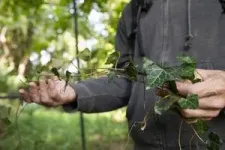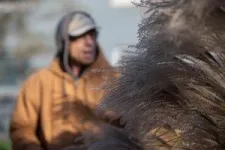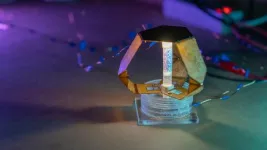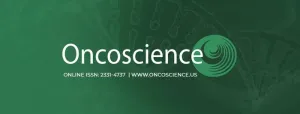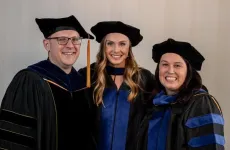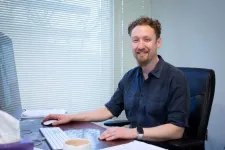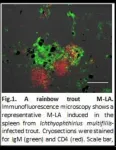(Press-News.org) Botanist Denis Conover does not have to go far to study the growing problem of invasive plants.
During an autumn stroll outside his office at the University of Cincinnati, the biology professor pointed out numerous examples of nonnative, invasive species in campus landscaping.
“This is winged euonymus, otherwise known as burning bush. And here is Chinese silver grass. It’s a popular ornamental, but the seeds are dispersed by the wind,” he said.
And there were many others: English ivy, wintercreeper, Callery pear.
For his latest study published in the journal Ecological Restoration, he and his students examined the impact that nonnative, invasive plants are having on forests. He found that plants at arboretums and public gardens inadvertently can seed wild areas with nonnative plants.
“The nonnative, invasive species are very detrimental to native ecosystems,” Conover said “Once they get going in the natural areas, they can take over and exclude the native plants and the animals that depend on them.”
The example he used was the arboretum at Cincinnati’s Spring Grove Cemetery, which has recorded more than 1,200 species of trees, shrubs, vines and other plants over its 178-year history. The arboretum is home to 26 noteworthy, mature trees known as “champions” for being the largest or best representation of their species, including a national champion September elm tree and an Ohio champion American yellowwood.
Conover said the arboretum is home to many beautiful native plants, including an enormous white oak that was a sapling when the Mayflower dropped anchor in Plymouth Colony. But Conover said some exotic plants at the arboretum are bearing fruit and seeds that are being carried by birds or the wind to neighboring woods.
Some exotic plants introduced to people’s yards and gardens will never pose a problem. But others can become invasive.
“You don’t know. It may take decades before they show any signs of being invasive, like the Callery pear tree,” Conover said.
UC has documented thousands of native and nonnative plant specimens at Spring Grove in surveys by people such as Kate Nordyke, the cemetery’s former herbarium specialist. Conover now serves in that role as a volunteer, documenting plants to create a record that future scientists can use to study changes in the region’s biodiversity over time.
“Despite its proximity to the city center, there is a substantial amount of intact greenspace at Spring Grove and the surrounding community,” Nordyke said. “This, in turn, supports a surprising diversity of plants and animals.”
Nordyke said she was alarmed by how easily some cultivated plants have spread to natural areas.
“Seeing this brought to light even more the importance of making informed choices about what we plant in our own yards and gardens,” she said.
Conservation technician Drew Goebel at Cincinnati City Parks said one example is the cemetery’s beautiful Amur cork tree, a state-record tree. Its seeds are sprouting in a park adjacent to the cemetery, Parker Woods Nature Preserve.
“There we found a population of 25 mature Amur cork trees. We took core samples and found that the oldest of them was 60 years old. The oldest six trees are male but then a female tree sprouted there and they began to take off,” Goebel said.
And nine years ago, volunteers cleared acres of nonnative, invasive Amur honeysuckle from Cincinnati park’s Buttercup Valley Nature Preserve, creating fertile ground for another invasive species, Higan cherry, to take hold, he said.
“We found a big stand of them — 50 or 60 that we pulled out all at once,” he said.
“The reason we don’t have more of these other invasives showing up is because another dominant invasive, Amur honeysuckle, was introduced in greater numbers and has already taken over that niche,” Goebel said.
Conover said Spring Grove has several large Higan cherry trees native to Asia.
“The trees have attractive flowers in the spring, but the fruits are eaten by birds that disperse the seeds into the natural areas,” he said.
David Gressley, director of horticulture at Spring Grove, said the cemetery is taking important steps to address the spread of invasive species. The cemetery stopped planting English ivy and wintercreeper, two common invasive species, and began replacing it with native ground covers.
“This is the first full season where I had a crew dedicated to invasive plant control,” Gressley said.
They were able to remove English ivy that covered most of a champion bald cypress tree. And they began removing porcelain berry, a vine from Asia known for its pretty blue and purple berries.
“We definitely put a dent in it,” he said. “It’s a continuous battle.”
Why does it matter?
“People who are trying to protect natural areas and preserve native plants and animals are spending huge amounts of time and money to eradicate nonnative, invasive plants,” Conover said. “The overuse of herbicides and mechanical equipment results in collateral damage to native plants and animals and to people.”
Meanwhile, Conover said, people continue to buy and plant invasive trees, shrubs and flowers for their yards instead of native alternatives, which benefit insects, birds and other wildlife.
Goebel said forests dominated by invasive species become degraded over time in more ways than one. Amur honeysuckle shades out and kills native ground-hugging plants and vines, he said. These forests don’t retain as much water or soil and provide far less wildlife habitat than native forests with their large variety of species.
“It’s not providing the same benefits to us, either, that a native forest would,” Goebel said. “It’s not going to sequester the same amount of carbon. It’s not going to mitigate stormwater runoff like it normally would. It weakens the whole system when it’s reduced to just a few species.”
But Goebel said there’s still time to do something about it.
“The good news is we’re at the beginning of the problem. If we can convince people to act when the problem is small, that’s the best time to intervene,” he said. “When it gets to the stage where it’s out of control like honeysuckle, you get to a breaking point where it’s just infeasible to deal with it.”
Study coauthor and UC graduate Olivia Canterbury said she thinks more should be done to educate people about invasive species, particularly emerging ones that could present a problem. Her father, ornithologist Ronald Canterbury, teaches in UC’s biology department.
“I was taken aback by the number of nonnative species I saw in Cincinnati's wooded areas,” she said. “I think our best solution is to keep bringing awareness to the issue and encouraging planting native species.”
Co-author Samantha Al-Bayer, a UC graduate, is now working in Guam, an island that has a long history of dealing with invasive species such as brown tree snakes that wiped out native birds.
“Invasive species hit a lot harder and faster on islands,” Al-Bayer said. “This is due to the island’s isolation and the lack of natural predators to control foreign species.”
When the birds disappeared, many of the plants lost their best or only ways of dispersing seeds. On the island of Guam, officials are vigilant to prevent brown tree snakes from reaching other nearby islands stowed away on airplanes or boats, she said.
“This is especially important for cargo being shipped to any of the other Marianas islands since those islands are still free of brown tree snakes and still have beautiful endemic birds,” Al-Bayer said.
Conover said homeowners can do something about invasive species, first by removing any on their properties. And they can choose to replace them with native trees, shrubs and flowers, he said.
“A ginkgo tree supports virtually none of our native insects or birds,” he said. “But if you plant a white oak, there will be several hundred species of insects eating its leaves and providing food for birds along with its acorns.
“So plant an oak,” he said.
END
Public gardens contribute to invasives problem
Survey finds nonnative, invasive species are escaping arboretums
2023-12-01
ELSE PRESS RELEASES FROM THIS DATE:
Rett patients receive a new gene therapy treatment at Texas Children’s Hospital and Baylor College of Medicine
2023-12-01
Texas Children’s Hospital, an internationally-recognized, top-ranked children’s hospital and pediatric research center affiliated with Baylor College of Medicine, is the first to deliver a novel gene therapy to treat Rett syndrome in pediatric patients. Two female patients with Rett syndrome were the first children worldwide to receive this promising treatment.
This exciting milestone is part of an ongoing first-in-human Phase I/II trial of a new investigational gene therapy, NGN-401, conducted by Neurogene Inc., a clinical-stage company founded to bring life-changing genetic medicines to patients ...
A color-based sensor to emulate skin's sensitivity
2023-12-01
Robotics researchers have already made great strides in developing sensors that can perceive changes in position, pressure, and temperature – all of which are important for technologies like wearable devices and human-robot interfaces. But a hallmark of human perception is the ability to sense multiple stimuli at once, and this is something that robotics has struggled to achieve.
Now, Jamie Paik and colleagues in the Reconfigurable Robotics Lab (RRL) in EPFL’s School of Engineering have developed a sensor that can perceive combinations of bending, stretching, compression, and temperature changes, all using a robust system that boils down ...
SFU researchers sound out Canadian military’s plan to combat ocean noise pollution
2023-12-01
new study from Simon Fraser University researchers examines the Canadian military’s efforts to reduce the impacts of underwater noise pollution on species during training exercises in the Pacific Ocean but caveat that more can still be done.
The paper, published today in Marine Policy, takes aim at a report commissioned by the Canadian Department of National Defence (DND) to reduce the effects of noise pollution from military small-arms munitions training within “Whiskey Hotel”, a 330-square-kilometre ...
Coverage of Bruce Willis’ frontotemporal degeneration shows media misconstrues the disease
2023-12-01
A new paper in Innovation in Aging, published by Oxford University Press, shows that a great deal of media coverage of the actor Bruce Willis’ condition, frontotemporal degeneration, was inaccurate, revealing the public’s limited knowledge of the disease.
In 2022, Willis’ family released a statement saying that he had been diagnosed with aphasia, an acquired language impairment, and would retire from acting. Ten months later, the family issued another statement indicating doctors had diagnosed Willis with a more specific condition, frontotemporal degeneration. ...
Potential pitfalls when using the Cre-LoxP system in cancer research
2023-12-01
“One limitation [of Cre-LoxP], the focus of this editorial, is the potential loss of fidelity of Cre recombinase expression especially in the context of modeling cancer in mice.”
BUFFALO, NY- December 1, 2023 – A new editorial paper was published in Oncoscience (Volume 10) on November 14, 2023, entitled, “Be mindful of potential pitfalls when using the Cre-LoxP system in cancer research.”
In this new editorial, researchers Piotr Czarnota and Jaroslaw Cisowski from Jagiellonian University discuss Cre-LoxP — a widely used system to conditionally modify gene expression in mouse models of cancer and other diseases.
“It ...
CHOP researchers discover deep structural biology connections that help improve CAR therapy
2023-12-01
Philadelphia, December 1, 2023 – Chimeric Antigen Receptors (CARs) have opened up an exciting new field of therapeutic advancements for rare and difficult-to-treat cancers, as they have the ability to deliver targeted therapies that can kill tumor cells. Peptide-centric CARs (PC-CARs) rely on specific peptide “barcodes,” which are derived from proteins within the cell created by potentially cancer-causing oncogenes, are designed to find and target cancer cells. These “barcodes” are displayed by human leukocyte antigens (HLAs), which help the immune system distinguish its own proteins from foreign invaders, ...
Can preeclampsia be prevented?
2023-12-01
NEWS RELEASE
EMBARGOED UNTIL FRI, DEC. 1 -- 2:00 P.M. EASTERN
Contact
Colleen McDonald - Sr. Consultant, Earned Media
414.801.3146 | cmcdonald@mcw.edu
Milwaukee, Wis. – Dec. 1, 2023 – Preeclampsia is a mysterious condition that occurs in about one of 10 pregnancies without any early warning signs. After 20 weeks or more of normal blood pressure during the pregnancy, patients with preeclampsia will begin to experience elevated blood pressure and may also have increased levels of protein in their urine due to hypertension reducing the filtering power of the kidneys. Prolonged hypertension due ...
Meditation training can support wellbeing in older adults
2023-12-01
Following an 18-month meditation programme can improve the wellbeing of older adults, finds a new randomised controlled trial by an international team co-led by UCL.
The findings, published in PLOS ONE, show that meditation can improve people’s awareness, connection to others, and insight.
While the meditation training did not confer significant benefits on two commonly used measures of psychological wellbeing and quality of life, the researchers say their findings may reveal limitations in existing methods of tracking wellbeing.
Lead author Marco Schlosser (UCL Psychiatry and University of Geneva) said: “As the global population ...
Research shows human behavior guided by fast changes in dopamine levels
2023-12-01
What happens in the human brain when we learn from positive and negative experiences? To help answer that question and better understand decision-making and human behavior, scientists are studying dopamine.
Dopamine is a neurotransmitter produced in the brain that serves as a chemical messenger, facilitating communication between nerve cells in the brain and the body. It is involved in functions such as movement, cognition and learning. While dopamine is most known for its association with positive emotions, scientists are also exploring ...
Scientists navigate uncharted waters in fish immunology research
2023-12-01
Upon infection or immunization, all jawed vertebrate species generate proteins called antibodies that bind and neutralize pathogens. Strong and long-lasting antibody responses in warm-blooded species such as mammals are produced in secondary lymphoid microstructures (SLMs) among which germinal centers (GCs) are the centerpiece. Despite the apparent absence of GCs or similar SLMs in cold-blooded vertebrates (e.g., fish), these species can mount significant antibody responses that can persist for several months. Thus, for decades, the outstanding question has remained as to how and where ...
LAST 30 PRESS RELEASES:
Why nail-biting, procrastination and other self-sabotaging behaviors are rooted in survival instincts
Regional variations in mechanical properties of porcine leptomeninges
Artificial empathy in therapy and healthcare: advancements in interpersonal interaction technologies
Why some brains switch gears more efficiently than others
UVA’s Jundong Li wins ICDM’S 2025 Tao Li Award for data mining, machine learning
UVA’s low-power, high-performance computer power player Mircea Stan earns National Academy of Inventors fellowship
Not playing by the rules: USU researcher explores filamentous algae dynamics in rivers
Do our body clocks influence our risk of dementia?
Anthropologists offer new evidence of bipedalism in long-debated fossil discovery
Safer receipt paper from wood
Dosage-sensitive genes suggest no whole-genome duplications in ancestral angiosperm
First ancient human herpesvirus genomes document their deep history with humans
Why Some Bacteria Survive Antibiotics and How to Stop Them - New study reveals that bacteria can survive antibiotic treatment through two fundamentally different “shutdown modes”
UCLA study links scar healing to dangerous placenta condition
CHANGE-seq-BE finds off-target changes in the genome from base editors
The Journal of Nuclear Medicine Ahead-of-Print Tip Sheet: January 2, 2026
Delayed or absent first dose of measles, mumps, and rubella vaccination
Trends in US preterm birth rates by household income and race and ethnicity
Study identifies potential biomarker linked to progression and brain inflammation in multiple sclerosis
Many mothers in Norway do not show up for postnatal check-ups
Researchers want to find out why quick clay is so unstable
Superradiant spins show teamwork at the quantum scale
Cleveland Clinic Research links tumor bacteria to immunotherapy resistance in head and neck cancer
First Editorial of 2026: Resisting AI slop
Joint ground- and space-based observations reveal Saturn-mass rogue planet
Inheritable genetic variant offers protection against blood cancer risk and progression
Pigs settled Pacific islands alongside early human voyagers
A Coral reef’s daily pulse reshapes microbes in surrounding waters
EAST Tokamak experiments exceed plasma density limit, offering new approach to fusion ignition
Groundbreaking discovery reveals Africa’s oldest cremation pyre and complex ritual practices
[Press-News.org] Public gardens contribute to invasives problemSurvey finds nonnative, invasive species are escaping arboretums

